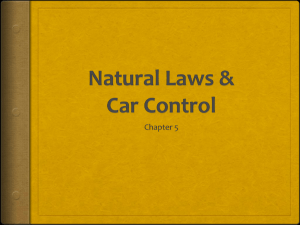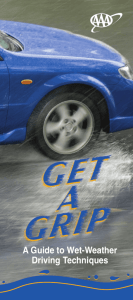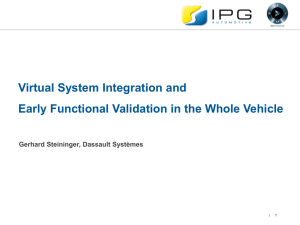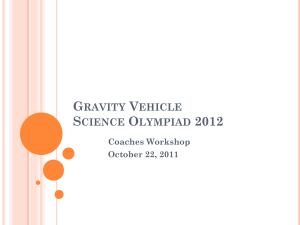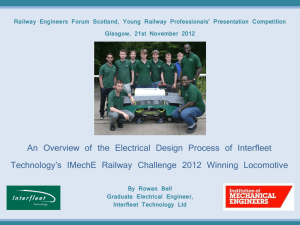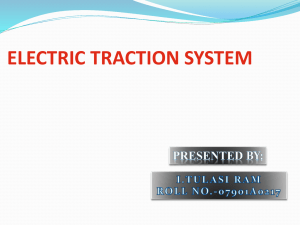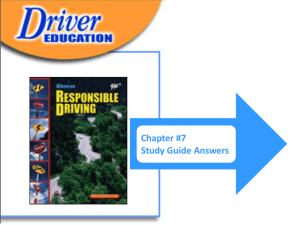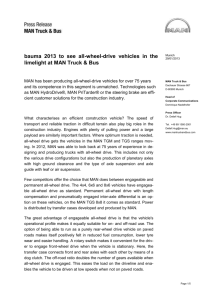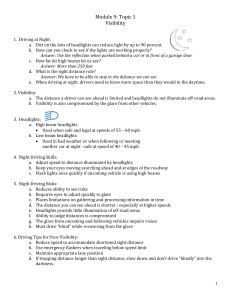Chapter 6
advertisement
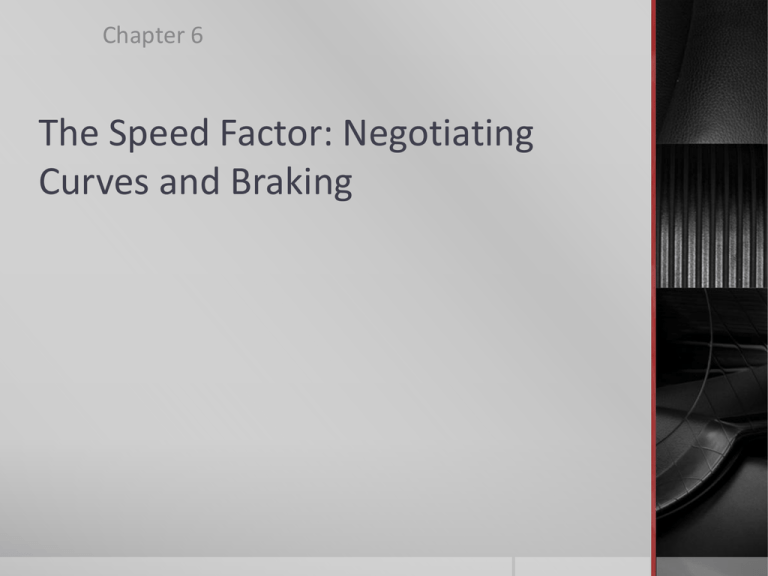
Chapter 6 The Speed Factor: Negotiating Curves and Braking 6.1 Physical Laws That Affect Driving Speed Refers to how fast something is moving/How quickly position is changing over time Measured in m/h or km/h Acceleration Measures the rate of change of an objects speed Increasing speed over a given period=acceleration Decreasing speed over a given period=deceleration Example… A car is traveling from point A to point E. At the beginning of point A, you are traveling 0mph. At the end of point C you are traveling 60mph. When you reach point D you are still traveling 60mph. When you stop at point E, you are traveling 0mph. A B C D E Starting Point 1 2 3 4 Gravity Force exerted by massive objects on another object to “attract”, or “pull” toward its center In terms of driving: When traveling uphill, gravity pulls your car towards the ground causing you to use more power for the engine to maintain speed When traveling downhill, it requires less power because you are moving in the direction that gravity is pulling you Traction Friction between your vehicle’s wheels and the surface of the road Necessary to move, change direction, and stop Keeps control of your vehicle Traction increases when the amount of tire tread touching the road increases Tread The grooved surface of the tire that grips the road. Water flows through the grooves 1/16 inch tread Police used a penny to test tread depth Inflation and Traction Check owner’s manual for best pressure When pressure is right, you get your best control, better gas mileage, and tire wear. Under-inflation Over-inflation Split Traction Reduced Traction Two things to maintain ideal levels of traction Vehicle must be in good condition Tires, shock absorbers, steering system Road must be smooth Snow, Ice, Rain, Gravel Reduced Traction Torque Ability of a force to cause an object to rotate In driving terms, it is the engine’s ability to apply more force to turn your wheels When the force applied to your wheels exceeds the force resisting(traction), your wheels WILL spin Inertia An object in motion stays in motion An object at rest will remain at rest Unless acted upon by a force Examples of inertia: Accelerating Decelerating/Braking Turning Crashing Kinetic Energy and force of Impact Kinetic Energy • The energy an object in motion has For a vehicle to stop, it must lose kinetic energy • Braking • Coasting • Impact Force of Impact • The force of a collision as determined by the magnitude of kinetic energy of the objects that collide and the distance over which the kinetic energy is lost • Softer objects spread have more “give” and will spread the force of impact over a greater distance • 3 Factors • Speed • Weight • Distance between impact and stopping Reducing Force of Impact Guard Rail Dashboards Bumpers Body of Car Air Bags 6.2 Negotiating Curves Centrifugal Force The outward force or “pull” experienced when traveling in a circular path In terms of driving, the inertia of your body attempting to continue traveling in a straight line as the vehicle changes direction Center of Gravity (COG) Point at which an object’s weight is centered Vehicles that are wide have a lower COG SUVs and Jeeps have higher COG Vehicles with higher COG have higher potential to roll or flip on sharp turns Loading Adding weight to your vehicle’s weight as measured when it is empty Can affect a vehicle’s COG You are loading your vehicle anytime you get in the car Increased loading will cause your vehicle to work harder Road Slopes Level Banked Crowned Banked Road Dips down in one direction so that one side is higher than the other Dips in the direction of the curve to reduce loss of traction Reduces incidence of rollover Some are banked the wrong way, must be aware Crowned Roads Higher in the center than the sides Promote runoff to reduce hydroplaning Can help or harm you, depending on the direction of travel Entering a Curve SPEED is only thing we can control Must reduce speed before entering the curve Reducing during the turn is extremely dangerous Road conditions Should be a last resort Maintain lane position Do not understeer or oversteer Slow in, Fast out Brake going into the turn and accelerate out 6.3 Braking How to brake Get to know how “touchy” the brakes are before you begin driving at high speeds Keep heel of right foot on the floor Move from accelerator to brake without lifting foot Anitlock Braking Systems (ABS) Sensors mounted on each wheel that determines whether the wheel locks or stops rotating during braking Sensor sends a signal to the microprocessor that controls the brakes Microprocessor tells the brakes to release enough pressure on that particular wheel to allow it to skid The microprocessor then tells the brake to increase pressure This is repeated many times a second You may feel a “pulsing” sensation Emergency Braking E-Brake Pumping the brakes For vehicles without ABS If done on a vehicle with ABS, it can send false information to the sensors and can cause the car to skid Stopping Distance Strong correlation between the speed you are traveling and the time required for you to stop. Your ability to stop smoothly, accurately, and rapidly depend on two things: Reaction distance • Distance traveled by your vehicle during the time it takes you to identify the need to stop • Depends on speed, visibility, and your mental and/or physical state • Faster you are moving and the harder it is to see, the longer it takes to react Braking distance • Distance needed to come to a complete stop once the brakes have been applied • Depends on vehicle type and weight, type and wear of tires, and condition of brakes Reaction distance + Braking distance = Stopping distance Total distance required to stop from the first time you recognize the need to brake to the time the vehicle is no longer moving SPEED is the most important factor • The faster you go, the longer it takes to stop 6.4 Speed Limits What is a safe driving speed? Factors that affect “safeness”: • Posted speed limits, weather conditions, visibility, surface condition of the roadway, traffic conditions, lane width, and any special speed laws (depends on the type of vehicle you are driving) • Posted Speed Limits • Maximum speed limit • Not there to recommend a driving speed • Minimum speed limit • Prevent drivers from moving at such slow speeds that they impede or block the normal flow of traffic Basic Speed Law Everyone has one It says that a driver should operate his/her vehicle at a speed that is reasonable for existing conditions Examples would include inclement weather, poor visibility, poor traffic conditions, or poor roadway surface Other Speed Laws Uniform Speed Zones • Provide speed limits in commonly encountered locations even where no max. or min. speed limits are posted • School zones • Railroad crossings • Alleys • Business districts • Residential districts • Rural highways • Interstate freeways Special Speed Laws • Slow moving vehicles • Trailers • Trucks or tractors with three or more axles

